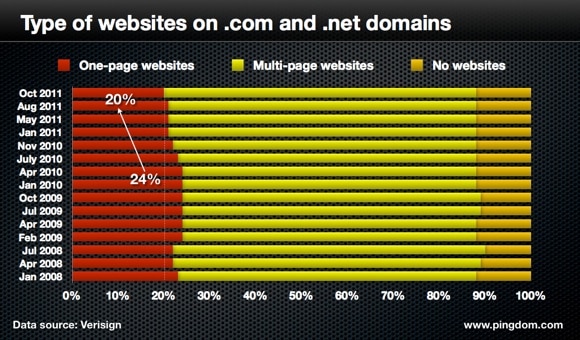
When visiting a website we usually expect it to have multiple pages.
But haven’t you also come across websites with just a single page? In other words, there’s just a homepage and nothing else to click on to.
Now it seems like the single-page website may be a dying breed. We looked at the numbers and here’s what we found.
20% of .com and .net websites are single-page sites
Verisign’s “State of the Domain” report that was just released presents figures from October 2011, in which we can read that an estimated 88% of .com and .net domains resolve to a website.
The report finds that .com and .net domains have reached a combined total of 112 million domain names, up from around 88 million in 1998.
Verisign has published about this since early 2008 and there is something interesting showing in the numbers recently: single-page websites have declined from 24% (in 2009-2010) of the total of .com and .net sites to 20% in the most recent report.

Sure, this is not a huge drop but keeping in mind that the single-page website share stayed steady at 24% for such a long time, a drop to 20% in about 16 months could be significant.
One reason could perhaps be that the typical use of one-page websites is of declining interest. According to Verisign, “one-page websites include under- construction, brochure-ware and parked pages in addition to online advertising revenue generating parked pages.”
Will the decline continue?
Although it’s probably too soon to say anything for sure regarding a possible trend for one-page websites, it does raise some interesting questions.
First and foremost is of course why this is happening, especially in light of the fact that the percentage of domains with no websites attached has held steady at 11-12% ever since 2008.
It could be just a short-term shift in the numbers, a shift that will turn around at some point. But it could also be that we’re seeing a start of a gradual decline of single-page websites.
If so, would you miss the single-page site? After all, single-page websites can be very functional and beautiful.
Picture credit: mkreyness.



























